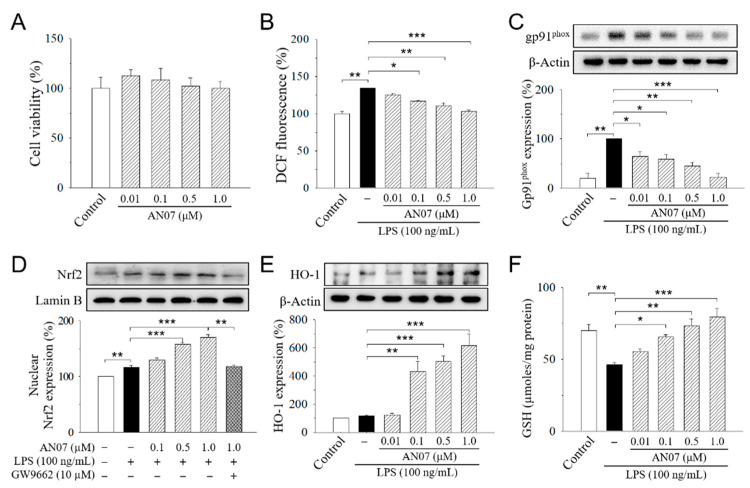Figure 2.
2-Hydroxy-4′-methoxychalcone (AN07) protects from lipopolysaccharide (LPS)-induced oxidative stress in RAW 264.7 cells. (A) Effects of AN07 on cell viability of RAW264.7 cells. RAW264.7 cells were treated with AN07 (0.01–1.0 μM) for 24 h, and cell viability was determined by 3-(4,5-dimethylthiazol-2-yl)-2,5-diphenyl-tetrazolium bromide (MTT) assay. (B–F) AN07 attenuates reactive oxygen species (ROS) production (B), reduces gp91phox protein expression (C), enhances the nuclear levels of the nuclear erythroid 2-related factor 2 (Nrf2) (D), increases heme oxygenase-1 (HO-1) expression (E), and rescues glutathione (GSH) depletion (F) in LPS-stimulated RAW264.7 cells. RAW264.7 cells were pre-treated with AN07 (0.01–1.0 μM) for 1 h and then exposed to LPS (100 ng/mL) for another 24 h. (B) ROS production was determined by Hoechst 33342, 2′,7′-dichlorodihydrofluorescein diacetate (H2DCF-DA) staining, and fluorescence of the 2′,7′-dichlorofluorescein (DCF) product was analyzed by flow cytometer, which was represented as percentages of the control group. (C–E) Upper panels, representative immunoblots. Lower panels, densitometry analyses of the relative ratio of gp91phox protein/β-actin protein, Nrf2/Lamin B protein, or HO-1 protein/β-actin protein, represented as percentages of control or LPS group. GW9662 (10 μM), a selective peroxisome proliferator-activated receptor-γ (PPARγ) antagonist. (F) GSH levels were determined using the commercial kit. The total amount of GSH was determined through a calibration curve and normalized to the protein concentration. Columns, mean ± S.E.M. from at least three independent experiments. * p < 0.05, ** p < 0.01, *** p < 0.001, compared with control or indicated groups.

